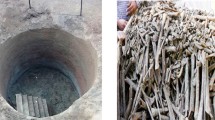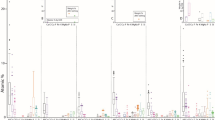Abstract
Elemental composition in bone of the different species has variation depending on genetic and environmental factors especially their food habitat. The aims of this study were to conduct an elemental analysis of Asian elephant teeth, both deciduous (first molar, second molar, and tusk) and permanent (molar and tusk), and compare the elemental composition of permanent teeth among 15 species, mostly mammalian. These teeth were analyzed using X-ray fluorescence at two voltages: 15 and 50 kV. In Asian elephants, deciduous tusk showed a lower Ca/Zn ratio compared to permanent tusk, because of the lack of Zn in permanent molars. Ca/Fe ratio was higher in deciduous than permanent molars. For permanent teeth, elephant molars presented a high Ca/Pb ratio but no Ca/Zn, Ca/Sr, and Zn/Fe ratios because of the lack of Zn and Sr in the samples tested. The key elemental ratios for differentiating elephant deciduous and permanent tusk were Ca/P and Ca/Zn. The considerable variation in elemental ratio data across 15 species was observed. All tooth samples contained Ca and P, which was not surprising; however, Pb also was present in all samples and Cd in a large majority, suggesting exposure to environmental contaminants. From discriminant analysis, the combination of Ca/P+Ca/Zn+Ca/Pb+Ca/Fe+Ca/Sr+Zn/Fe can generate two equations that successfully classified six (dog, pig, goat, tapir, monkey, and elephant) out of 15 species at 100 % specificity. In conclusion, determining the elemental profile of teeth may serve as a tool to identify the tooth “type” of elephants and to potentially classify other species.






Similar content being viewed by others
Abbreviations
- F:
-
Fluorine (9)
- Al:
-
Aluminum (13)
- Si:
-
Silicon (14)
- P:
-
Phosphorous (15)
- S:
-
Sulfur (16)
- Ca:
-
Calcium (20)
- Cr:
-
Chromium (24)
- Fe:
-
Iron (26)
- Co:
-
Cobalt (27)
- Ni:
-
Nickel (28)
- Cu:
-
Copper (29)
- Zn:
-
Zinc (30)
- Br:
-
Bromine (35)
- Sr:
-
Strontium (38)
- Mo:
-
Molybdenum (42)
- Rh:
-
Rhodium (45)
- Cd:
-
Cadmium (48)
- Hf:
-
Hafnium (72)
- Hg:
-
Mercury (80)
- Ti:
-
Titanium (81)
- Pb:
-
Lead (82)
- U:
-
Uranium (92)
References
Chen PY, Lin AY, Lin YS, Seki Y, Stokes AG, Peyras J, Olevsky EA, Meyers MA, McKittrick J (2008) Structure and mechanical properties of selected biological materials. J Mech Behav Biomed Mater 1(3):208–226
Fischer A, Wiechuła D, Przybyła-Misztela C (2013) Changes of concentrations of elements in deciduous teeth with age. Biol Trace Elem Res 154(3):427–432
Christensen AM, Smith MA, Thomas RM (2012) Validation of X-ray fluorescence spectrometry for determining osseous or dental origin of unknown material. J Forensic Sci 57(1):47–51
Kierdorf U, Stoffels D, Kierdorf H (2014) Element concentrations and element ratios in antler and pedicle bone of yearling red deer (Cervus elaphus) stags—a quantitative X-ray fluorescence study. Biol Trace Elem Res 162(1–3):124–133
Carvalho ML, Casaca C, Marques JP, Pinheiro T, Cunha AS (2001) Human teeth elemental profiles measured by synchrotron X-ray fluorescence: dietary habits and environmental influence. X Ray Spectrom 30:190–193
Carvalho ML, Marques JP, Marques AF, Casaca C (2004) Synchrotron microprobe determination of the elemental distribution in human teeth of the Neolithic period. X Ray Spectrom 33:55–60
Amr AM (2011) Trace elements in Egyptian teeth. Int J Phys Sci 6(27):6241–6245
Pemmer B, Roschger A, Wastl A, Hofstaetter JG, Wobrauschek P, Simon R, Thaler HW, Roschger P, Klaushofer K, Streli C (2013) Spatial distribution of the trace elements zinc, strontium and lead in human bone tissue. Bone 57(1):184–193
Wiedner EB, Takeuchi NY, Isaza R, Barbe D (2011) Baseline levels of trace metals in blood of captive Asian elephants (Elephas maximus). J Zoo Wildl Med 42(2):360–362
Brown CJ, Chenery SR, Smith B, Mason C, Tomkins A, Roberts GJ, Sserunjogi L, Tiberindwa JV (2004) Environmental influences on the trace element content of teeth—implications for disease and nutritional status. Arch Oral Biol 49(9):705–717
Beattie JH, Avenell A (1992) Trace element nutrition and bone metabolism. Nutr Res Rev 5(1):167–188
Gonzalez-Rodriguez J, Fowler G (2013) A study on the discrimination of human skeletons using X-ray fluorescence and chemometric tools in chemical anthropology. Forensic Sci Int 231(1–3):407, e401-406
Kozawa Y, Mishima H, Suzuki K, Ferguson MWJ. Dental formula of elephant by the development of tooth germ. In: Proceedings of the first International Congress: The World of Elephants, Rome, 16-20th October 2001. pp 639–642
Zougrou IM, Katsikini M, Pinakidou F, Paloura EC, Papadopoulou L, Tsoukala E (2014) Study of fossil bones by synchrotron radiation micro-spectroscopic techniques and scanning electron microscopy. J Synchrotron Radiat 21(Pt 1):149–160
Baldassarri M, Margolis HC, Beniash E (2008) Compositional determinants of mechanical properties of enamel. J Dent Res 87(7):645–649
He B, Huang S, Zhang C, Jing J, Hao Y, Xiao L, Zhou X (2011) Mineral densities and elemental content in different layers of healthy human enamel with varying teeth age. Arch Oral Biol 56(10):997–1004
Prozesky VM, Raubenheimer EJ, van Heerden WFP, Grotepass WP, Przybylowicz WJ, Pineda CA, Swart R (1995) Trace element concentration and distribution in ivory. Nucl Instrum Meth Phys Res 104(1–4):638–644
Raubenheimera EJ, Browna JMM, Ramab DBK, Dreyerc MJ, Smithc PD, Dauthc J (1998) Geographic variations in the composition of ivory of the African elephant (Loxodonta africana). Arch Oral Biol 43(8):641–647
Parkpian P, Leong ST, Laortanakul P, Thunthaisong N (2003) Regional monitoring of lead and cadmium contamination in a tropical grazing land site, Thailand. Environ Monit Assess 85(2):157–173
Chanpiwat P, Sthiannopkao S (2014) Status of metal levels and their potential sources of contamination in Southeast Asian rivers. Environ Sci Pollut Res Int 21(1):220–233
Chongsuvivatwong V, Kaeosanit S, Untimanon O (2011) Twenty-six tons of lead oxide used per year in wooden boat building and repairing in Southern Thailand. Environ Geochem Health 33(3):301–307
Youravong N, Chongsuvivatwong V, Teanpaisan R, Geater AF, Dietz W, Dahlén G, Norén JG (2005) Morphology of enamel in primary teeth from children in Thailand exposed to environmental lead. Sci Total Environ 348(1–3):73–81
Alomary A, Al-Momani IF, Obeidat SM, Massadeh AM (2013) Levels of lead, cadmium, copper, iron, and zinc in deciduous teeth of children living in Irbid, Jordan by ICP-OES: some factors affecting their concentrations. Environ Monit Assess 185(4):3283–3295
Appleton J, Lee KM, Sawicka Kapusta K, Damek M, Cooke M (2000) The heavy metal content of the teeth of the bank vole (Clethrionomys glareolus) as an exposure marker of environmental pollution in Poland. Environ Pollut 110(3):441–449
Nofs SA, Atmar RL, Keitel WA, Hanlon C, Stanton JJ, Tan J, Flanagan JP, Howard L, Ling PD (2013) Prenatal passive transfer of maternal immunity in Asian elephants (Elephas maximus). Vet Immunol Immunopathol 153(3–4):308–311
Dhonukshe-Rutten RA, Lips M, de Jong N, Paw MJCA, Hiddink GJ, van Dusseldorp M, De Groot LC, van Staveren WA (2003) Vitamin B-12 status is associated with bone mineral content and bone mineral density in frail elderly women but not in men. J Nutr 133(3):801–807
Locke M (2008) Structure of ivory. J Morphol 269(4):423–450
Singh RR, Goyal SP, Khanna PP, Mukherjee PK, Sukumar R (2006) Using morphometric and analytical techniques to characterize elephant ivory. Forensic Sci Int 162(1–3):144–151
Balter V (2004) Allometric constraints on Sr/Ca and Ba/Ca partitioning in terrestrial mammalian trophic chains. Oecologia 139(1):83–88
Peek S, Clementz MT (2012) Ontogenetic variations in Sr/Ca and Ba/Ca ratios of dental bioapatites from Bos taurus and Odocoileus virginianus. J Trace Elem Med Biol 26(4):248–254
Anderson RA (1992) Chromium, glucose tolerance, and diabetes. Biol Trace Elem Res 32(1–3):19–24
Gomez S, Rizzo R, Pozzi-Mucelli M, Bonucci E, Vittur F (1999) Zinc mapping in bone tissues by histochemistry and synchrotron radiation-induced X-ray emission: correlation with the distribution of alkaline phosphatase. Bone 25(1):33–38
Landete-Castillejos T, Currey JD, Ceacero F, García AJ, Gallego L, Gomez S (2012) Does nutrition affect bone porosity and mineral tissue distribution in deer antlers? The relationship between histology, mechanical properties and mineral composition. Bone 50(1):245–254
Mashele S (2011) Application of analytical tools in the conservation of the African elephant (Loxodonta africana). JAPS 21(2):161–164
Acknowledgments
The authors wish to acknowledge Miss Nutcatcher Pitakarnnop for her diligent laboratory work. Special thanks to Dr. Patcharaporn Kaewmong, Phuket Marine Biological Center, Thailand and Dr. Raksiri Nomsiri, Chiang Mai Night Safari, Thailand from the Animal Anatomy Museum, Department of Veterinary Bioscience and Public Health, Faculty of Veterinary Medicine, Chiang Mai University for providing all samples used in this study. The authors are also grateful for research funding from the Elephant Research and Education Center, Faculty of Veterinary Medicine, Chiang Mai University, Chiang Mai, Thailand and Faculty of Veterinary Medicine, Chiang Mai University, Chiang Mai, Thailand.
Conflict of Interest
The authors declare that they have no competing interests.
Authors’ Contributions
KN designed and performed the experiments. KB performed the statistical analysis. CS and CT supported elephant sample. KN, JLB, and CT wrote the paper. All authors read and approved the final manuscript.
Author information
Authors and Affiliations
Corresponding author
Rights and permissions
About this article
Cite this article
Nganvongpanit, K., Brown, J.L., Buddhachat, K. et al. Elemental Analysis of Asian Elephant (Elephas maximus) Teeth Using X-ray Fluorescence and a Comparison to Other Species. Biol Trace Elem Res 170, 94–105 (2016). https://doi.org/10.1007/s12011-015-0445-x
Received:
Accepted:
Published:
Issue Date:
DOI: https://doi.org/10.1007/s12011-015-0445-x




